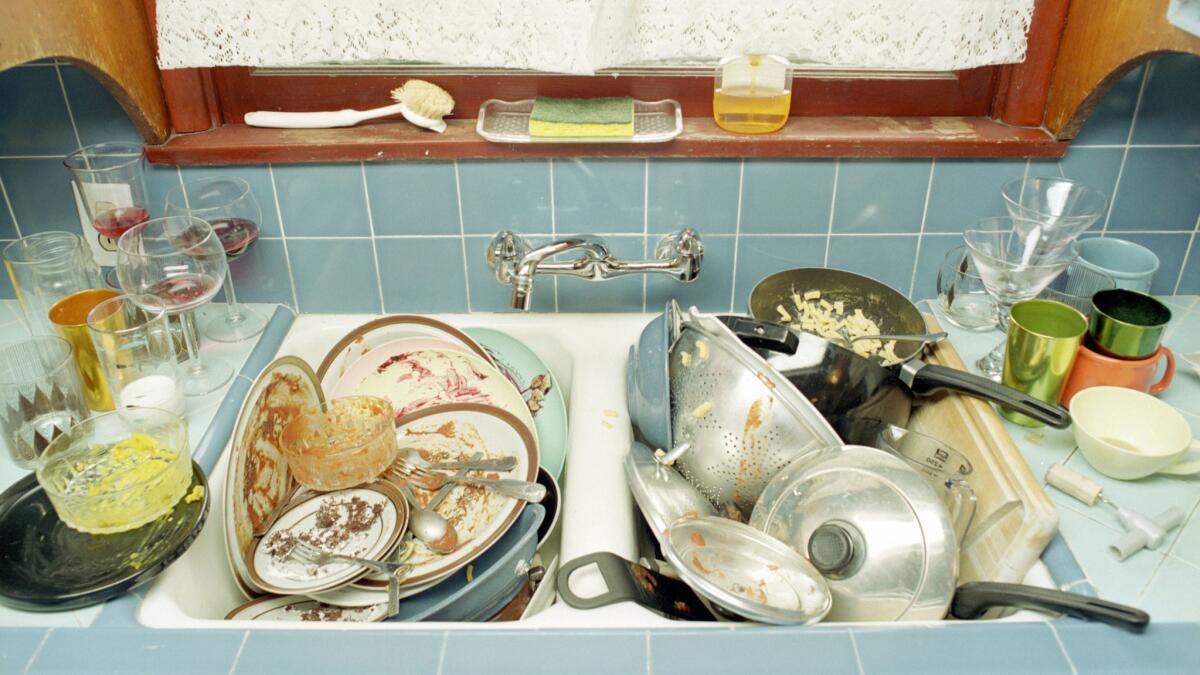How to do the dishes faster

- Share via
My mom didn’t teach me how to cook but she did impart a vital lesson behind washing dishes: Enjoy it.
When I asked my mom how anyone could like it, she replied, “It’s not about the washing. It’s the satisfaction of completely finishing a task.” That feels especially important now when you might not feel motivated to tackle that to-do list, uncertainty reigns and work-life balance is, well, unbalanced. Also, the pile of dirty dishes is insane.
As with cooking, there are some who are naturals at dishwashing and others who, um, need a little help. And no, this isn’t a passive-aggressive message to my kids — though you’re welcome to forward this story to yours. (My aggressive-aggressive message to my kids: Fold your laundry!)
I sincerely like washing dishes now. Here’s how I do them:

Scrape and spray
Dishwashing will be harder for you later if you let oatmeal cake onto your bowl now. Right after eating, scrape whatever solids are left into the trash, including napkins. (Yes, pet peeve. You know someone has to pluck that napkin out of the sink, right?) If there’s still gunk on your plates, rinse them off, using a blast from the spray function if you have it.
Start soaking
During and right after cooking, spray and soak any prep bowls, pots and pans with hot water to make scrubbing them much easier after eating. Slip cooking tools and utensils into those hot baths to prevent anything from crusting on them.

Stack smart
Group similarly sized items, with bigger platters and dishes on the bottom pyramiding to smaller saucers and bowls on top. Like a game of Tetris, you will lose if larger shapes pile over gaping spaces. For special delicate items, wash, dry and put away right away or keep them safe on the counter next to the sink.
Knives out
Wash and store them right away so you don’t accidentally stab yourself. If you want to save knife-washing for one big dish session, designate a safe space for them in the sink and make sure the blades lie flat.
Dishwashing machine? Create a system
If you’re using a dishwasher, first figure out how you can fit the most in the machine without anything breaking. Then, load by the groups already established in the sink.
Handwashing? Scrub well on all sides
As you may be able to tell by now, I’m a little Type A when it comes to dishwashing (and generally keeping the kitchen spotless). But it is actually important to wash every dish surface well, including the undersides of pots and pans and baking sheets. I know you don’t eat, cook or bake on those sides, but you don’t want them to end up with a greasy film that makes them permanently sticky. There may be cooked-on blackened splotches you can’t scrub off and that’s OK. As long as the grease layer goes away, you’re good.
Get in the zone
Instead of seething with resentment at the dishes that need to be washed, take the time to enjoy the space you have to think about whatever you want, including nothing at all. If I’m washing dishes to get ready for a big cooking session, I mentally plan out my steps or consider different seasonings and techniques. If I’m exhausted at the end of a long day, I put on music and zone out.
Start fresh
I used to put all my dishes away, then start cooking, serving and cleaning again. But in this nonstop quarantine kitchen life cycle, I’ve told my kids that unless they’re going to empty the dishwasher, they should use the clean dishes from it. That saves a now seemingly unnecessary step of putting away something just to pull it out again. But do put away anything that won’t be used again soon.
Here’s a bonus tip: The best dish rack is the regular inexpensive one. My colleague Ben Mims and I wash tons of dishes and have tried flat drying mats and fancy angled or adjustable rack models. We stand by the standard rectangular dish rack with vertical slats, a drip tray and a utensil caddy — it’s a sturdy workhorse that holds the most and costs the least.
More to Read
Eat your way across L.A.
Get our weekly Tasting Notes newsletter for reviews, news and more.
You may occasionally receive promotional content from the Los Angeles Times.











